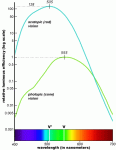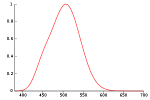Krogith
0
- Joined
- Dec 12, 2010
- Messages
- 1,195
- Points
- 0
That's cool -
I have much more detailed CIE data in there though - so it would be ideal if I could figure out the Rayleigh math to add to the equation, and it would be a pretty darn good comparison tool.
If nobody remembers that thread off hand, I'll re-do the research this weekend, and add it to the tool.
I'm off for the evening.
That will be awesome, Good Work bud.
We should make a sticky for all these type of programs and have em all in one thread.







